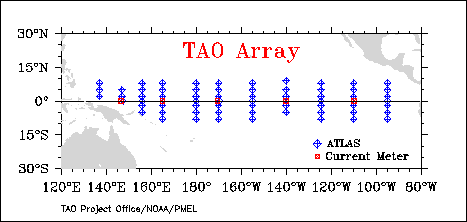Buoys for ocean-surface conditions
|
E. Linacre and B. Geerts |
3/’02 |
![]()
|
One problem plaguing weather and climate forecasts is the lack of information over the oceans. Satellite remote sensing provides detailed information about cloudiness, sea surface temperature, amongst others, but many variables such as rainfall, and ocean salinity and temperature profiles, can only be measured in situ, i.e. by ships or buoys. In January 1997 there were about 172 buoys at sea to measure atmosphere and ocean conditions worldwide. Some of these buoys were moored and many were floating free (1). The data collected at each of these buoys would be transmitted periodically to a passing satellite, which would download the information later, while flying over a receiving station. |
Fig 1.The array of Tropical Atmosphere Ocean moored buoys.
|
There is a dense network of some 70 buoys located within 10 degrees of the equator between the Galapagos Islands and New Guinea (Fig 1). This is the Tropical Atmosphere Ocean (TAO) buoy array. The TAO array was established in 1994 by France, Japan, Korea, Taiwan, and the United States, to monitor the El Niño Southern Oscillation. Notwithstanding the great depth of the tropical Pacific Ocean, he TAO buoys are anchored (Fig 2). They measure wind direction and speed, air temperature and humidity (Fig 3), and temperature of the ocean at the surface and at various depths to 500 meters below the surface. A few buoys also measure currents, rainfall, and solar radiation.
More information on buoys around the USA, visit the National Buoy Data Center. The US maintains about 60 moored buoys, as well as some floating buoys and 60 Coastal Marine Automated Network (C-MAN) stations. C-MAN stations are AWSs installed on lighthouses, at capes and beaches, on near shore islands, and on offshore platforms.

Fig 3. A TAO buoy being serviced.
Reference
(1) Petty, G.W., 1995: Frequencies and characteristics of global oceanic precipitation from shipboard present-weather reports. Bull. Amer. Meteor. Soc., 76, 1593-1616.
